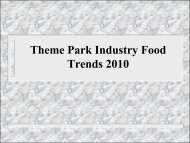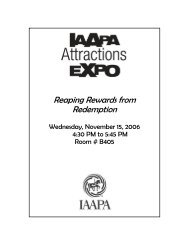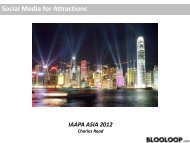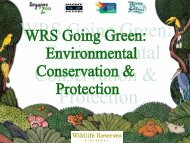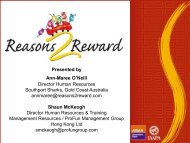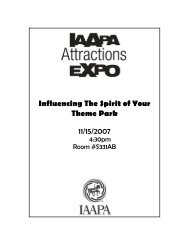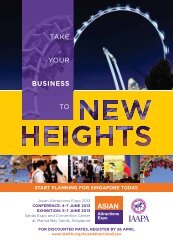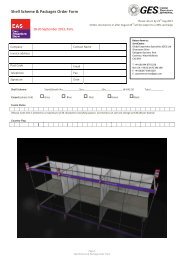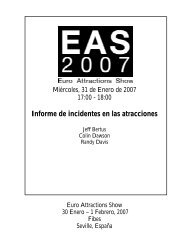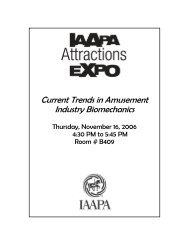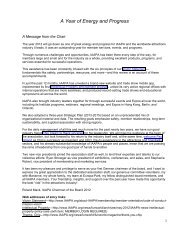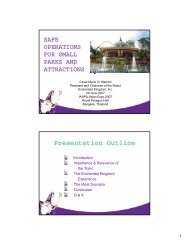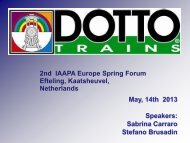Harmonization of Amusement Ride - IAAPA
Harmonization of Amusement Ride - IAAPA
Harmonization of Amusement Ride - IAAPA
You also want an ePaper? Increase the reach of your titles
YUMPU automatically turns print PDFs into web optimized ePapers that Google loves.
<strong>Harmonization</strong> <strong>of</strong> <strong>Amusement</strong> <strong>Ride</strong><br />
Safety Standards Around the World<br />
Mike Whithers, Whithers,<br />
Disney
Global <strong>Amusement</strong> <strong>Ride</strong><br />
Standards <strong>Harmonization</strong><br />
Working Towards Common<br />
World <strong>Amusement</strong> <strong>Ride</strong> Safety<br />
Standards<br />
Greg Hale, <strong>IAAPA</strong> Safety and Maintenance Committee Chairman<br />
Randy Davis, <strong>IAAPA</strong> Government Relations, Vice President<br />
Mike Withers, ASTM International F - 2291 Task Force Chairman
Agenda<br />
<strong>Harmonization</strong> Process – Brief Overview<br />
CEN TC 152 – EN 13814 Revision?<br />
ASTM International Approach to<br />
<strong>Harmonization</strong><br />
Individual Country Updates<br />
<strong>Harmonization</strong> Task Group Updates<br />
4
World <strong>Amusement</strong> Industry<br />
Safety Standard <strong>Harmonization</strong><br />
<strong>IAAPA</strong>’s COMMITMENT:<br />
Host the international harmonization effort as part <strong>of</strong> the three annual<br />
meetings in Europe, Asia and the US<br />
Enlist international amusement safety standard experts:<br />
• International and national amusement industry organizations (e.g.<br />
<strong>IAAPA</strong>, EAASI, AIMS, RAAPA, etc.)<br />
• International and national standards organizations (e.g. ., ASTM<br />
International, CEN, UNI, JIS, TAAS, EMSD, NAFLIC, GOST, etc.)<br />
Promote the revision <strong>of</strong> existing international standards to minimize technical<br />
differences and incorporate best practices for safety<br />
Promote the adoption <strong>of</strong> existing international standards by developing<br />
nations without standards and by nations with existing unique standards<br />
5
World <strong>Amusement</strong> Industry<br />
Safety Standard <strong>Harmonization</strong><br />
Through international cooperation on safety issues –<br />
the worldwide amusement parks and attractions<br />
industry will continue to be one <strong>of</strong> the safest forms <strong>of</strong><br />
recreation available to the public.<br />
6
World Meetings<br />
DATE LOCATION TOPIC<br />
November 2003 <strong>IAAPA</strong> – Orlando Informational and Organizational<br />
January 2004 Euro <strong>Amusement</strong> Show - Paris Informational and Organizational<br />
July 2004 <strong>IAAPA</strong> Asian EXPO - Singapore Informational & Task Group on Acceleration<br />
November 2004 <strong>IAAPA</strong> – Orlando Informational & Task Group on Acceleration and Fencing<br />
January 2005 Euro <strong>Amusement</strong> Show – Vienna Informational & Task Group on Acceleration, Fencing, and Restraint<br />
Systems<br />
July 2005 <strong>IAAPA</strong> Asian EXPO – Hong Kong Informational & Task Group on Restraint System Requirements<br />
November 2005 <strong>IAAPA</strong> – Atlanta ASTM Task Group on Acceleration Limits<br />
Nineteenth<br />
January 2006 Euro <strong>Amusement</strong> Show – Vienna Restraint Systems<br />
July 2006 <strong>IAAPA</strong> Asian EXPO – Shanghai: Status Chinese <strong>Amusement</strong> <strong>Ride</strong> Standards & Russian Federal Standard<br />
Presentations<br />
International<br />
November 2006 <strong>IAAPA</strong> – Atlanta ASTM Task Group on Acceleration Limits<br />
January 2007 Euro <strong>Amusement</strong> Show – Seville International Model Language Restraint Systems<br />
Meeting<br />
July 2007 <strong>IAAPA</strong> Asian EXPO – Bangkok International Model Language Acceleration Limits<br />
November 2007 <strong>IAAPA</strong> Asian EXPO – Orlando Informational, Setup Model Language Task Groups<br />
January 2008 Euro <strong>Amusement</strong> Show – Nice Informational & Task Groups on Control Systems and Restraint Systems<br />
July 2008 Asia Attractions Expo – Macau, S.A.R. Informational & ASTM International Standards Process<br />
September 2008 EAS 2008 - Munich ASTM F 24.24 First International Sub-Committee Meeting<br />
November 2008 <strong>IAAPA</strong> - Orlando ASTM & EN Task Groups Reports<br />
June 2009 <strong>IAAPA</strong> - Korea Informational and Organizational<br />
October 2009 Euro Attractions Show - Amsterdam Informational and Organizational – 2nd F 24.24 Sub-Committee Meeting<br />
November 2009 <strong>IAAPA</strong> Attractions Expo – Las Vegas Informational and Organizational<br />
7
Why Support <strong>Amusement</strong> <strong>Ride</strong> Safety<br />
World Standard <strong>Harmonization</strong>?<br />
Incorporate international best practices for amusement rides,<br />
creating a common blueprint for ride safety throughout the world<br />
Leverage the thousands <strong>of</strong> hours <strong>of</strong> work that has gone into ASTM<br />
F2291, En 13814 (published 12/2004) and other international and<br />
national standards by ride safety experts<br />
Ensure that nations developing new amusement ride safety<br />
standards adopt international best practices and consistent global<br />
requirements<br />
Encourage efficient design and production processes through<br />
standardization and the minimization <strong>of</strong> product differences due to<br />
differing standards and regulations<br />
Have one place to incorporate “lessons learned” to continue to<br />
enhance the safety <strong>of</strong> all amusement rides worldwide<br />
8
International <strong>Amusement</strong> <strong>Ride</strong> Standards<br />
<strong>Harmonization</strong> Proposal<br />
Host & Meeting<br />
Organization<br />
Intl <strong>Amusement</strong> Industry<br />
& Standards Org.<br />
Designate Delegates<br />
& Contributing Experts<br />
Japan/JIS<br />
<strong>IAAPA</strong> Safety & Maintenance Committee<br />
<strong>Harmonization</strong> Task Group<br />
Chairperson<br />
ASTM Int.<br />
China/CAAPA<br />
S. Korea<br />
Hong Kong/<br />
EMSD<br />
<strong>IAAPA</strong><br />
EASSI<br />
Australia<br />
AIMS<br />
Canada/TSSA<br />
<strong>Harmonization</strong><br />
Task Group<br />
Singapore<br />
RAAPA<br />
CEN<br />
Member Nations<br />
UNI<br />
S. America
Multi-Phase Multi Phase Approach<br />
Phase I<br />
Worldwide experts select “best practices” from existing<br />
standards that can be consistently incorporated into existing<br />
standards.<br />
Phase II<br />
Representatives influence changes within their own international<br />
standards organizations to bring about harmonization.<br />
Commitment: ASTM International F-24 Committee will keep F-2291<br />
revised and current with the input from the <strong>IAAPA</strong> <strong>Harmonization</strong><br />
Committee.<br />
CEN to revise EN 13814?<br />
Phase III<br />
Work together on new topics that are not sufficiently addressed in<br />
any <strong>of</strong> the existing standards so that new content is already<br />
harmonized before it is adopted into existing standards.<br />
10
Initial <strong>Harmonization</strong> Task Group Focus<br />
Paris 2004 Meeting Consensus:<br />
Patron Acceleration Limits and Data Measurement<br />
Fencing, Guardrails, Steps, Ramps and Catwalks<br />
Restraint System and Clearance Envelope Requirements<br />
Risk and Hazard Analysis<br />
Control Systems<br />
Loads and Strengths<br />
11
<strong>Harmonization</strong> Process<br />
Model Language Task Groups and Chairman:<br />
Acceleration Limits Emmett Peter<br />
Restraint Systems,<br />
Containment and<br />
Clearance Envelope Mike Withers<br />
Loads and Strengths Steve Blum<br />
Control Systems Richard Barnes<br />
Fencing, Gates Chris Deaves<br />
Risk Assessment Steve King<br />
Guest Behavior Gianni Chiari<br />
Terminology All the above<br />
12
<strong>Harmonization</strong> Process<br />
<strong>Harmonization</strong> Meeting Representation:<br />
Standards & Regulatory Organizations:<br />
Albania Drejtoria e Pergithshme e Standardizimit<br />
Bolivia Instituto Boliviano de Normalizacion u Calidad<br />
Brazil Brazilian Association <strong>of</strong> amusement Industries<br />
Canada Canadian Technical Standards & Safety Authority<br />
Chile Insittuto Nacionale de Normalization<br />
China Special Equipment Inspection and Research<br />
Colombia Instituto Colombiano de Norms Tecncas y Certification<br />
Croatia State Office for Standardization and Metrology<br />
Ecuador Instituto Ecuatoriano de Normalizacion<br />
Europe Comite European De Normalisation<br />
Great Britain FAFLIC, BSI, ADIPS<br />
Hong Kong Electrical & Mechanical Services Department <strong>of</strong> Hong Kong S.A.R.<br />
Jamaica Bureau <strong>of</strong> Standards<br />
Japan Japanese Standards Association<br />
Netherlands Det Norske Veritas & Voedsel en Waren Autoriteit<br />
Romania Asociatia de Standardizare din Romania<br />
Russian State Committee <strong>of</strong> the Russian Federation for Standardization an Metrology<br />
Saint Lucia Standards Department<br />
Trinidad Trinidad & Tobago Bureau <strong>of</strong> Standards<br />
United StatesASTM International<br />
Uruguay Instituto Uruguayo de Normas Tecnicas<br />
Zimbabwe Standards Association <strong>of</strong> Zimbabwe<br />
<strong>Amusement</strong> Industry Associations – <strong>IAAPA</strong>, RAAPA, CAAPA, IAAPI, EASSI, AIMS, AAPRA,<br />
BALPPA<br />
13
International <strong>Amusement</strong> <strong>Ride</strong><br />
Standards Used to Develop Model Language<br />
ASTM International – F 2291- 09a Standard Practice for the Design <strong>of</strong><br />
<strong>Amusement</strong> <strong>Ride</strong>s and Devices<br />
European Standard – EN 13814 – Fair Ground and <strong>Amusement</strong> Park Machinery<br />
and Structure Safety<br />
Russia – Safety <strong>of</strong> <strong>Amusement</strong> <strong>Ride</strong>s, General Requirements<br />
Australia – AS 3533.1 with Draft Section 2 – <strong>Amusement</strong> <strong>Ride</strong>s & Devices<br />
Design and Construction<br />
India – Code Of Practice for <strong>Amusement</strong> <strong>Ride</strong> Safety<br />
Malaysia – Guidelines on Safety Management <strong>of</strong> <strong>Amusement</strong> Park Devices<br />
Hong Kong – Code Of Practice <strong>Amusement</strong> <strong>Ride</strong>s - EMSD<br />
China – GB 18159-2000, GB 8408-2000 & GB 18158-2000<br />
Great Britain – Safety <strong>of</strong> <strong>Amusement</strong> Devices Chapter 10 Passenger Units and<br />
Containment<br />
14
International <strong>Amusement</strong> <strong>Ride</strong><br />
Safety Standards Comparison <strong>of</strong> Content<br />
Euro Norm prEN 13814 Fairground & <strong>Amusement</strong><br />
Park Machinery and Structures – Safety<br />
Requirements for design and manufacture <strong>of</strong> rides and<br />
structures<br />
ASTM F2291 – Practice for Design <strong>of</strong> <strong>Amusement</strong><br />
<strong>Ride</strong>s and Devices<br />
ASTM F 2291 Standard Practice for Design <strong>of</strong> amusement<br />
<strong>Ride</strong>s and Devices ASTM F 1193 Standard Practice for<br />
Quality, Manufacture, and Construction <strong>of</strong> amusement <strong>Ride</strong>s<br />
and Devices<br />
Risk reduction by prevailing design and safety measures ASTM F 2291 5. General Design Criteria 5.1 <strong>Ride</strong> Analysis:<br />
General ASTM F 2291 5. General Design Criteria 5.1 <strong>Ride</strong> Analysis:<br />
Hazard analysis ASTM F 2291 5.1.1.3 Failure Analysis-<br />
Risk reduction for platforms, ramps, floors, stairs and<br />
walkways<br />
Not covered by ASTM covered by:<br />
Local Building Codes e.g. CA Code <strong>of</strong> Regulations, Title 24<br />
Part 2<br />
Risk reduction by the use <strong>of</strong> railings, fencing and guarding ASTM F 2291 14. Fencing, Guardrails, Handrails, and<br />
Gates for <strong>Amusement</strong> <strong>Ride</strong>s and Devices<br />
Risk reduction in the case <strong>of</strong> access and egress ASTM F 2291 6. Patron Restraint, Clearance Envelope,<br />
and Containment Design Criteria<br />
Risk reduction for passenger units ASTM F 2291 6. Patron Restraint, Clearance Envelope,<br />
and Containment Design Criteria<br />
Risk reduction by special provisions ASTM F 2291 6. Patron Restraint, Clearance Envelope,<br />
and Containment Design Criteria<br />
Sample <strong>of</strong> content comparison between EN 13814 & ASTM F 2291<br />
15
International <strong>Amusement</strong> <strong>Ride</strong><br />
Safety Standards<br />
EN 13814 Revision ?<br />
Informal Committee Meeting Amsterdam<br />
9/28/09 -9/29/09 9/29/09<br />
16
ASTM International’s<br />
International s<br />
Approach to Global<br />
<strong>Amusement</strong><br />
<strong>Harmonization</strong><br />
Len Morrissey, Director - TCO Division
<strong>Harmonization</strong>: An ASTM<br />
International Experience<br />
Committee F24 on <strong>Amusement</strong> <strong>Ride</strong>s and Devices: A World<br />
Standard for <strong>Amusement</strong> <strong>Ride</strong> Design<br />
The need: need:<br />
a single, universally acceptable standard that<br />
defines acceleration limits, allowable G-forces, G forces, clearance<br />
envelopes, fencing requirements, restraint capabilities and<br />
other important aspects <strong>of</strong> amusement ride design that will<br />
be accepted in all countries.<br />
A goal from the outset: outset:<br />
to encompass the common elements<br />
<strong>of</strong> the U.S. and existing or in-development in development standards from<br />
around the world in a new and comprehensive design<br />
standard.<br />
The result: result:<br />
Produced the World Standard for <strong>Amusement</strong><br />
<strong>Ride</strong> Design - F2291
International Implementation -<br />
The Strategy: Create Partnerships<br />
International trade associations<br />
• <strong>IAAPA</strong>, OABA, AIMS, NARSO, WWA<br />
Federal / States / Local / International Jurisdictions<br />
• Over 30 States Reference F24 Standards in Regulation<br />
International Organizations<br />
• CSA / CEN / UNI / RAAPA<br />
Direct Participation by all Industry Stakeholders<br />
• <strong>Ride</strong> engineers, manufacturers, park owners, operators,<br />
regulators, consumer advocacy groups, and other parties<br />
Goal<br />
• Minimize Major Differences / Eliminate<br />
Duplication<br />
• Meet regulatory requirements <strong>of</strong> all<br />
countries
Develop Creative Regional Solutions<br />
MoU Progam<br />
Updating Standards based on direct<br />
Collaboration with CEN, Australia and<br />
Others<br />
Region Specific Standards<br />
Official Translations
ASTM Memorandum <strong>of</strong> Understanding (MoU ( MoU) )<br />
Program<br />
Formal Agreements designed to:<br />
• Encourage, increase, and facilitate the<br />
participation <strong>of</strong> technical experts from around<br />
the world in the ASTM standards<br />
development process<br />
• Broaden the global acceptance and use <strong>of</strong><br />
ASTM International standards<br />
• Over 60 agreements with National Standards<br />
Bodies currently in place
The CSA & ASTM F24<br />
Partnership<br />
<strong>Harmonization</strong> Subcommittee Created<br />
Goal<br />
• Compare F24 Standards and CSA Z267<br />
Guidance<br />
• Identify differences by category<br />
ASTM guidance is preferred<br />
Canadian guidance is preferred and has universal<br />
application<br />
Requirements are Canadian specific but do not have<br />
universal application (ie ( ie – Canadian electrical code<br />
requirements)
CSA & ASTM F24<br />
Path Forward<br />
• Universally acceptable changes will<br />
be balloted as revisions to current<br />
ASTM Standards<br />
• Canadian Specific Requirements<br />
will be balloted as annexes or<br />
appendices to ASTM Standards<br />
• Z267 will be withdrawn and replaced<br />
by appropriate references to ASTM<br />
Standards in Canadian regulation
Anticipated Results<br />
One, universally accepted set <strong>of</strong> guidance<br />
covering amusement rides in North America<br />
Elimination <strong>of</strong> conflicting and inconsistent<br />
guidance for designers, manufacturers,<br />
inspectors, regulators and operators in the<br />
amusement industry<br />
Creation <strong>of</strong> a framework to address other<br />
nation or region specific issues within ASTM<br />
F24 Standards
Official Translations <strong>of</strong> ASTM Standards
<strong>IAAPA</strong> Global <strong>Amusement</strong> <strong>Ride</strong> Safety Standards<br />
<strong>Harmonization</strong> Task Group Contacts:<br />
Greg Hale<br />
Chief Safety Officer, VP Worldwide Accessibility and Safety<br />
Walt Disney Theme Parks and Resorts<br />
greg.hale@disney.com<br />
1 407 824 5636<br />
Randy Davis<br />
VP Government Relations<br />
<strong>IAAPA</strong><br />
rdavis@iaapa.org<br />
1 703 299 5753<br />
Mike Withers<br />
VP Show/<strong>Ride</strong> Engineering<br />
Walt Disney Imagineering<br />
mike.r.withers@disney.com<br />
1 818 544 6800<br />
Thank You<br />
26



